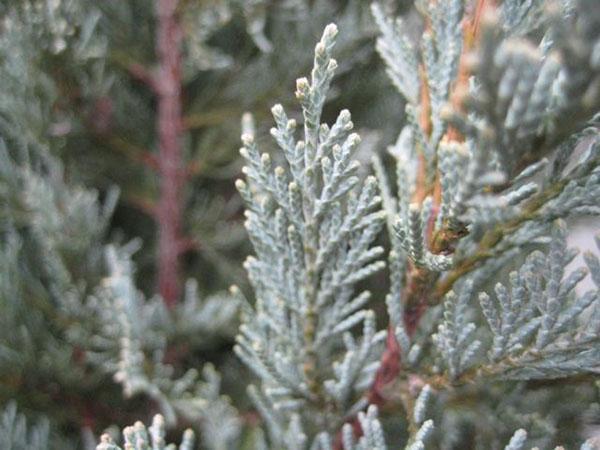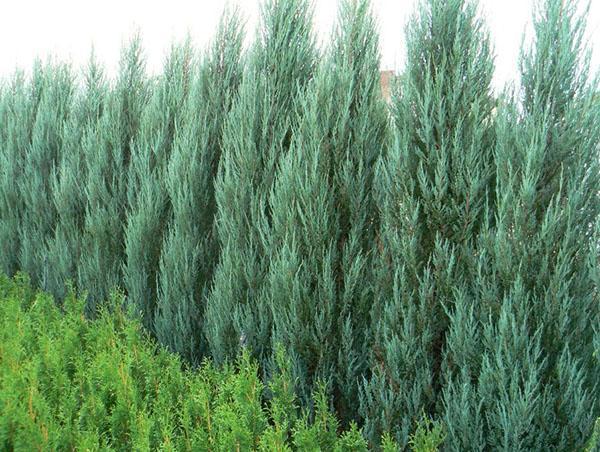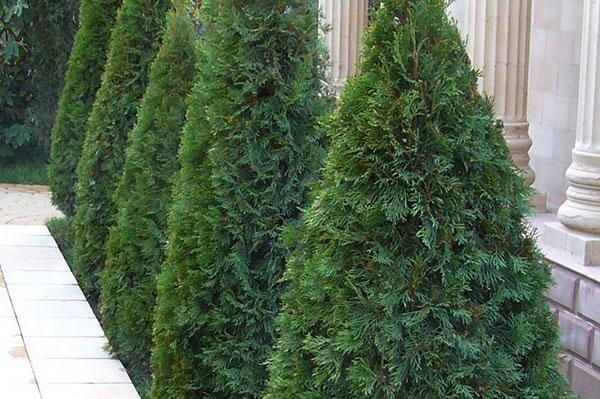The secret of a flawless landscape is rocky juniper
 Modern landscape design is not complete without conifers, they make the surrounding landscape saturated, bright and unusual, filling it with color, aroma and texture as much as possible. Rocky juniper is a favorite among other similar plants for competent garden decoration and spectacular decor of a personal plot. Its obvious decorative advantages include - many shapes, sizes and colors, a variety of coniferous texture, unpretentiousness to environmental conditions, a slow growth rate and no need for cutting. In landscape compositions, juniper can be planted singly and grow in groups. In combination with deciduous and coniferous species, it always looks picturesque and beautiful!
Modern landscape design is not complete without conifers, they make the surrounding landscape saturated, bright and unusual, filling it with color, aroma and texture as much as possible. Rocky juniper is a favorite among other similar plants for competent garden decoration and spectacular decor of a personal plot. Its obvious decorative advantages include - many shapes, sizes and colors, a variety of coniferous texture, unpretentiousness to environmental conditions, a slow growth rate and no need for cutting. In landscape compositions, juniper can be planted singly and grow in groups. In combination with deciduous and coniferous species, it always looks picturesque and beautiful!
Rocky juniper varieties
The rocky juniper is distinguished by its high growth - more than 10 meters, original needles, resembling scales tightly adjacent to each other, and a long crown, starting almost from the ground itself. The fruit of the juniper is a blue-colored cone-berry up to 4 mm in diameter. In the cut of the cone, there are two seeds that ripen in the second year of the plant's life. The culture has been known since 1839, it grows well among rocks, has many varieties, each of which is absolutely adapted to the growing conditions on the territory of Russia.
Rocky Juniper Skyrocket

Rocky juniper Blue Arrow
 Due to the constantly retaining bluish shade of the needles, it is considered the most popular variety. It established itself on the territory of central Russia - from the western borders and practically to the Urals. Juniper Blue Arrow or Blue Arrow, as its name sounds in translation, looks beautiful and solemn. The branches of this tall shrub are densely gathered into a cone and directed upward. Nature itself made its shape perfect, so no additional effort is required to maintain its appearance.
Due to the constantly retaining bluish shade of the needles, it is considered the most popular variety. It established itself on the territory of central Russia - from the western borders and practically to the Urals. Juniper Blue Arrow or Blue Arrow, as its name sounds in translation, looks beautiful and solemn. The branches of this tall shrub are densely gathered into a cone and directed upward. Nature itself made its shape perfect, so no additional effort is required to maintain its appearance.
Juniper rock Munglow
 This coniferous plant is a tall pyramidal shrub. Its needles are soft and not prickly, they have a beautiful silvery-bluish tint, in winter the color becomes even more saturated and intense. Juniper Moonglow grows quickly, is not picky about the soil and quality of care, is resistant to drought and winds. Due to the original color and impressive size, it will become a bright color spot in any garden composition.
This coniferous plant is a tall pyramidal shrub. Its needles are soft and not prickly, they have a beautiful silvery-bluish tint, in winter the color becomes even more saturated and intense. Juniper Moonglow grows quickly, is not picky about the soil and quality of care, is resistant to drought and winds. Due to the original color and impressive size, it will become a bright color spot in any garden composition.
Juniper rocky Blue Haven
 This variety is recognized as the best in color of needles among blue rocky junipers, its tone does not change all year round.The plant has a natural canonical shape with ideal proportions, reaches a height of 5 meters or more, and grows in diameter from 1.5 to 2 meters. Often planted in groups in the form of hedges and alleys, has high winter hardiness and wind resistance, it is adapted to urban living conditions.
This variety is recognized as the best in color of needles among blue rocky junipers, its tone does not change all year round.The plant has a natural canonical shape with ideal proportions, reaches a height of 5 meters or more, and grows in diameter from 1.5 to 2 meters. Often planted in groups in the form of hedges and alleys, has high winter hardiness and wind resistance, it is adapted to urban living conditions.
The description of the rocky juniper connects it with the southern cypresses, only as a more resistant and hardy coniferous plant. In natural nature, there are about 70 species of juniper, and only about 20 varieties are considered cultivated people. Among them, there are giant, medium-sized and dwarf plants, with a wide variety of colors, quality and structure of needles, spreading and compact crowns, with creeping and straight trunks.
Juniper in landscape design
 Rock juniper is an ideal choice for gardens and areas with regular and clear geometry, decorated in Scandinavian or English styles, made in the form of a Japanese or Alpine garden. The unpretentious ephedra will 100% play the role of the central spectacular link in the garden composition, and will also become a wonderful backdrop for other objects and plants.
Rock juniper is an ideal choice for gardens and areas with regular and clear geometry, decorated in Scandinavian or English styles, made in the form of a Japanese or Alpine garden. The unpretentious ephedra will 100% play the role of the central spectacular link in the garden composition, and will also become a wonderful backdrop for other objects and plants.
 Photo of rocky juniper in landscape design surprise with their uniqueness and amaze with beauty. The plant harmoniously coexists with other coniferous crops, deciduous trees and shrubs, flowers and herbs, stones, ponds and sculptures.
Photo of rocky juniper in landscape design surprise with their uniqueness and amaze with beauty. The plant harmoniously coexists with other coniferous crops, deciduous trees and shrubs, flowers and herbs, stones, ponds and sculptures.
Juniper Benefits in Landscape Design and Modeling:
- Variety in terms of species, shapes, heights, colors and properties.
- External showiness, originality and beauty.
- Unique compatibility with other plants and design elements.

- Unpretentiousness to growing conditions and climate, undemanding to care, reproduction and maintenance.
- Increased resistance to harsh climatic conditions while maintaining excellent decorative features and natural characteristics.
- Possibility of options for single and group disembarkation.

- Suitable for registration lawns and borders in urban areas, an ideal way to design rock gardens, embossing terrain and rocky landscapes.
Juniper is rightfully called the king of gardening art, this coniferous culture has all the external data, natural properties and features for this.
Planting, care features, reproduction
 Planting of rocky juniper with seedlings is carried out from mid-spring or during the onset of early autumn. Subject to certain requirements, he tolerates transplantation to a new place well and quickly takes root. The culture needs sun and protection from the wind, fertile and moist soils are not suitable, the plant loves freedom - the distance between coniferous representatives should be no closer than 1.5-2 meters.
Planting of rocky juniper with seedlings is carried out from mid-spring or during the onset of early autumn. Subject to certain requirements, he tolerates transplantation to a new place well and quickly takes root. The culture needs sun and protection from the wind, fertile and moist soils are not suitable, the plant loves freedom - the distance between coniferous representatives should be no closer than 1.5-2 meters.
Caring for a juniper is simple:
- in a dry season, water as needed;
- periodically remove weeds and loosen the ground;
- spray only in the presence of pests and diseases;
- feeding nitrogen and complex fertilizers are produced twice a season;
- a haircut is permissible only in certain varieties;
- dry branches are removed as they appear;
- in winter, some varieties are tied in order to prevent the breakage of young branches from wind and snow.

Reproduction of rocky juniper occurs by cuttings or young layers, in the case of valuable species - by grafting. Cutting is carried out by upper semi-lignified shoots, which are cut off with a knife edge together with older sections of wood. Layers are used exclusively for creeping juniper forms throughout the growing season. The stripped shoots are fixed with hairpins in the prepared soil, where they take root fully within six months and a year.Grafting of a valuable variety to common juniper is done by professional gardeners, this method is rarely used.
Cutting is a universal propagation method for all varieties of juniper. Cuttings are planted throughout the year, but the best time of the year for this is spring.
Planting and caring for rocky juniper directly depends on the selected variety. To grow a lush and powerful plant with a rich and beautiful color scheme of needles means knowing and following all the rules and nuances of care. Gardeners choose junipers to maintain the theme of the all-season garden, as it remains attractive in any season of the year, without exception. All options for horizontal and vertical use of this coniferous plant are suitable for location on a flower bed, since there are high and medium varieties of juniper, shrub-like, undersized and creeping along the ground.
 Rocky juniper is able to successfully complement any landscape style - classic and avant-garde, traditional and ethnic, elegant and modern, while emphasizing the originality and expressiveness of the surrounding natural landscape. Coniferous crops fit into gardens and parks of all sizes - from miniature gardens to vast parklands and tourist recreation areas.
Rocky juniper is able to successfully complement any landscape style - classic and avant-garde, traditional and ethnic, elegant and modern, while emphasizing the originality and expressiveness of the surrounding natural landscape. Coniferous crops fit into gardens and parks of all sizes - from miniature gardens to vast parklands and tourist recreation areas.